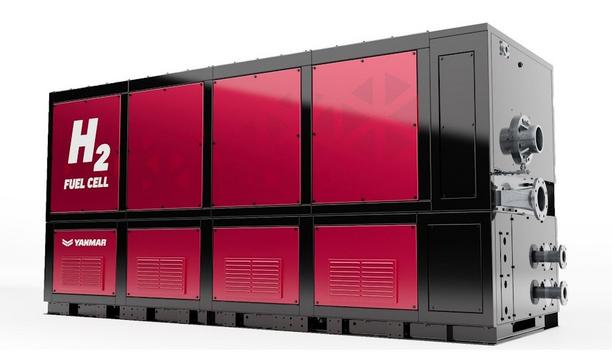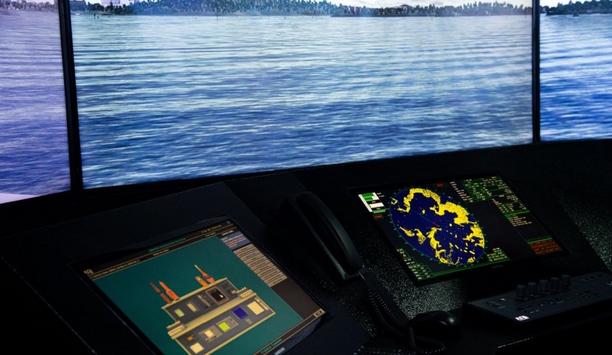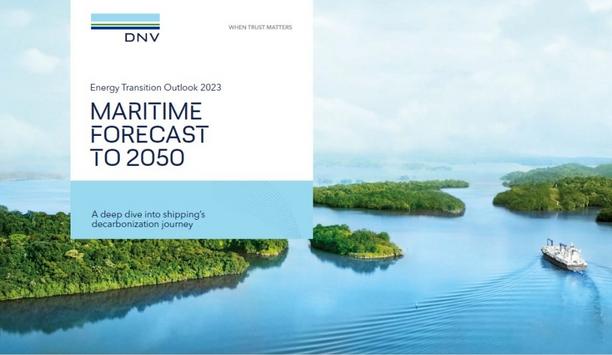DNV - Experts & Thought Leaders
Latest DNV news & announcements
Yanmar Power Technology Co., Ltd. (Yanmar PT), a subsidiary of Yanmar Holdings, has received an Approval in Principle (AiP) for its GH320FC Maritime Hydrogen Fuel Cell System from the classification society, DNV. The GH320FC is designed as a next-generation power source for marine applications with an innovative design that facilitates easy installation on various types of vessels. The system also allows for multiple units to be connected in parallel and offers flexibility in the number of hydrogen fuel cell modules, enabling it to meet diverse power requirements across different ship types and operations. GH320FC Maritime Hydrogen Fuel Cell System “We are excited about this new milestone in meeting our customers’ needs for sustainable clean energy solutions in the marine sector,” said Eric Tigelaar, Department Manager of the Commercial Marine Department at Yanmar Europe. Eric Tigelaar adds, “Our hydrogen fuel cell system is particularly well suited for applications, such as coastal passenger ferries, inland waterway cargo vessels, port service vessels and operations in low or zero emission zones across Europe.” Masaru Hirose, Director and General Manager of Large Power Products Business at Yanmar Power Technology Co., Ltd, stated: “This is a significant milestone in bringing our hydrogen fuel cell solutions to European customers. Drawing on our experience with previous installations, such as the hydrogen fuel cell system being used on a coastal passenger ferry currently in commercial operation in Japan, we believe our solutions can help the customers to achieve their decarbonisation goals.” Maritime industry pushes towards decarbonisation Olaf Drews, Head of Engines & Pressurised Equipment at DNV Maritime, remarked: “As the maritime industry pushes forward towards decarbonisation, we need to examine every option that offers full zero-emission operations. And fuel cells in combination with clean renewably produced fuels are a highly efficient and scalable power solution to meet this challenge.” Olaf Drews adds, “DNV is very pleased to award this AiP to Yanmar and to partner with such a future focused company to help set the stage for shipping’s next generation of vessels. We look forward to building on this great cooperation, working together to safely realise the benefits of this innovative technology for the maritime industry.”
Collaboration between countries and sectors needs to strengthen as the North Sea undergoes a period of diversification, according to a new report from DNV. North Sea Forecast: Ocean’s Future to 2050 estimates that offshore wind will claim 9% of the North Sea space by 2050, and policies to promote cross-industry collaboration are required to ease spatial planning pressure. The North Sea hosts Europe’s busiest ports, produces most of Europe’s offshore energy, and is the area with the biggest fisheries catch. Energy production from offshore oil DNV estimates that the area claimed from offshore wind alone will exceed 60,000 square kilometres in 2050 Offshore wind capacity in the North Sea is projected to grow six-fold by 2050, reaching 214 GW, which will be on par with energy production from offshore oil and gas. DNV estimates that the area claimed from offshore wind alone will exceed 60,000 square kilometres in 2050. In total, ocean infrastructure will occupy 23% of the North Sea area in 0–50 m water depth and 2–50 km from shore. Green energy ambitions While offshore wind is projected to grow, this is still not sufficient to meet the green energy ambitions of the Ostend Declaration for the North Sea. Supply chain bottlenecks on the maritime side need to be addressed. North Sea ports need to quadruple the capacity of facilities dedicated to offshore wind construction. There is also the need for more vessels to install and service the turbines. North Sea’s oil production North Sea’s oil production will decrease to 800,000 barrels per day in 2050, less than a fifth of now The North Sea’s oil production will decrease to 800,000 barrels per day in 2050, less than a fifth of what it is now. Gas has more staying power due to its strategic importance to Europe, with production forecast to reduce to 60 billion cubic metres per day, almost two-thirds less than in 2024. “The North Sea is central to Europe’s energy, food and supply chain security. Collaboration across borders and sectors is required to enhance security in the North Sea and to overcome challenges, such as ocean health, spatial competition and infrastructure for the offshore wind sector,” said Bente Pretlove, Director of Food and Ocean Systems at DNV. Demand for seafood and good management practices The North Sea will remain an important source of food. Due to an increased demand for seafood and good management practices, North Sea fisheries will be able to retain the same catch volumes as now. Norway and the UK will increase aquaculture output, but the majority of that growth will be in cooler waters further north. EU’s policies relating to marine spatial planning EU’s policies relating to marine spatial planning differs to that of both Norway and the UK The report highlights how five of the world’s ten pioneering maritime cities are situated on the North Sea which gives the region the infrastructure, financial power and expertise to deal with the challenges. However, there is a lack of policy standardisation which makes sustainable growth difficult. The EU’s policies relating to marine spatial planning differs to that of both Norway and the UK. As of now, only a few countries can claim to have integrated ecosystem-based management into their spatial planning. Transition to new energy systems Torgeir Sterri, Director Offshore Classification at DNV, said, "The North Sea is a shared and highly productive space that sits at the core of Europe's Blue Economy. Its evolving landscape demands closer coordination across borders and sectors. For the offshore industry, this means adapting to a more integrated approach to regulation, spatial planning, and technology." Torgeir Sterri adds, "Our mission is to support stakeholders in navigating this complexity and ensure safe operations, while facilitating the transition to new energy systems."
As part of Singapore Maritime Week, DNV has awarded Marine Design and Research Institute of China (MARIC), Approval in Principle (AiP) for their new wide beam ammonia-ready Kamsarmax bulk carrier. The vessel has a shallow draft for flexible port calls, as well as being WAPS (wind-assisted propulsion system) ready. Greenhouse gas reduction goals Green ammonia is emerging as a strong candidate for climate-neutral fuel for shipping Green ammonia is emerging as a strong candidate for the climate-neutral fuel shipping needs to meet its greenhouse gas reduction goals, especially when produced from renewably produced energy and inputs. In 2024, the first orders for non-gas carrier ammonia-fuelled vessels were placed, mainly in the bulk carrier segment, highlighting ammonia's emergence as a real option in the alternative fuel market. Kamsarmax bulk carrier design To support the industry’s interest in the new fuel, DNV has awarded an AiP to Maric for a new ammonia-ready Kamsarmax bulk carrier design. With a length of 229 m and an increased beam of 38m, the design has been optimised for more cargo volume at same draft. The hull structure is reinforced, and space is reserved for an easier retrofit of both the ammonia tanks and system. With 4,500 CBM capacity tanks, the vessel can cover more than 15,000 nautical miles at design speed-fuelled on ammonia. Global decarbonisation goals DNV has awarded an AiP to Maric for a new ammonia-ready Kamsarmax bulk carrier design Mr Zhu, Jianzhang, Vice President of MARIC, says: “We are proud to announce our strategic collaboration with DNV, to pioneer the design of a 91k DWT ammonia-fuelled bulk carrier. This partnership underscores our commitment to advancing green shipping technologies and accelerating the maritime industry’s transition to a low-carbon future." "By working together, we can overcome the technical and operational challenges associated with ammonia as a marine fuel, deliver a cutting-edge solution that aligns with global decarbonisation goals, and set a new benchmark for clean, efficient, and commercially viable bulk carriers.” Advanced classification standards Øyvind Pettersen, Head of Technical Centre China, at DNV Maritime said: "Awarding MARIC this AiP is another milestone in advancing ammonia as a marine fuel. However, realising its potential demands both innovation and an unwavering focus on safety." "This is why we value working with MARIC and their commitment to building on the foundation of the industry's most advanced classification standards. DNV is very proud to collaborate on this AiP, which will strengthen confidence in new fuels, and further shipping’s journey toward a more sustainable tomorrow." Ships for future ammonia propulsion The first edition of DNV’s classification rules for ammonia-fuelled ships was published in 2021 The first edition of DNV’s classification rules for ammonia-fuelled ships was published in 2021. Updates followed in 2022 and 2023, including the Gas Fuelled Ammonia class notation, which gives owners the option to start building ships for future ammonia propulsion, by setting out the requirements for the ship’s fuel system, fuel bunkering connection, and piping through to the fuel consumers. Shipowners with insights and tools This year, a new DNV white paper, “Safe introduction of alternative fuels – Focus on ammonia and hydrogen as ship fuels”, provides shipowners with insights and tools to navigate the evolving regulatory landscape and implement these fuels. An Approval in Principle (AiP) is an independent assessment of a concept within an agreed framework, confirming that the design is feasible, and no significant obstacles exist to prevent the concept from being realised.
Insights & Opinions from thought leaders at DNV
More than almost any trend, decarbonisation is driving the future of maritime. That reality alone makes decarbonisation the perfect topic for our first-ever Expert Panel Roundtable column. Traditional maritime fuels, like heavy fuel oil, release harmful pollutants that contribute to air pollution and have adverse health effects. We have to do better, and discussions in the maritime industry centre on which combination of alternative fuels and other technologies can solve the shorter- and longer-term challenges of decarbonisation. For an update on the various approaches, we asked our Expert Panel Roundtable: What are the latest maritime technology trends in decarbonisation?
The maritime industry is taking important steps to improve cybersecurity, catching up rapidly by introducing other industries' best practices into information technology (IT) and operational technology (OT) onboard vessels. Work remains to be done to ensure a cyber-resilient worldwide fleet of maritime operations. The way forward is through collaboration among all major stakeholders. Remote-controlled and autonomous ships In the future, the marine industry will increasingly use remote-controlled and autonomous ships and infrastructure. One can imagine multi-ship, multi-infrastructure hybrid scenarios where a software failure or a cyber-attack could result in widespread damage. “Protecting this advanced marine industry will drive the need for even higher levels of cybersecurity, reliability, and robustness of marine automation systems and software,” says Svante Einarsson, Head of Maritime Cyber Security Advisory, DNV Cyber. Cybersecurity insights CyberOwl complements DNV Cyber with advanced analytics and threat management for maritime vessels Einarsson shares additional insights into cybersecurity for the maritime industry in our recent interview. DNV expanded its cybersecurity capabilities by acquiring Applied Risk in 2021 and Nixu in 2023, forming DNV Cyber with over 500 experts. This merger enhances maritime cybersecurity by integrating IT and industrial control system security services, offering comprehensive solutions from risk assessment to incident response. CyberOwl complements DNV Cyber with advanced analytics and threat management for maritime vessels, ensuring real-time threat monitoring and support to sustain regulatory compliance. Maritimeinformed.com: What are the cybersecurity vulnerabilities in the maritime market? What are the possible consequences and/or worst-case scenarios? Einarsson: The maritime industry faces several cybersecurity vulnerabilities, including the integration of IT and OT systems, unsecured Internet of Things (IoT) devices, outdated software, weak authentication, and human factors like phishing. The consequences of breaches can be severe, such as operational disruption, data theft, ransomware attacks, cyber-physical attacks, and supply chain disruption. A worst-case scenario includes hybrid incidents that compromise both IT and OT systems at the same time within highly trafficked areas (such as a port). Depending on the available time and alternative means, the vessel might run aground resulting in major oil spills, environmental disasters, and/or significant loss of life. These vulnerabilities and potential impacts highlight the critical need for robust cybersecurity measures in the maritime sector. Maritimeinformed.com: What is the role of regulations when it comes to cybersecurity in the maritime market, including IMO, IACS, and critical infrastructure regulations? How do regulations drive better cybersecurity practices? The EU’s NIS2 directive enforces robust cybersecurity strategies and incident reporting Einarsson: Regulations play a crucial role in maritime cybersecurity by setting global standards and ensuring compliance. The International Maritime Organisation (IMO) mandates cyber risk management in Safety Management Systems, while the International Association of Classification Societies (IACS) requires cybersecurity integration in systems and ships throughout the lifecycle of a vessel for new builds contracted after July 1, 2024. The EU’s NIS2 directive enforces robust cybersecurity strategies and incident reporting. These regulations drive better practices by standardising frameworks, holding organisations accountable, promoting holistic risk management, enhancing transparency, and fostering continuous improvement. This comprehensive regulatory approach forces all stakeholders in the industry (yards, vendors, and ship managers) to act and work together to implement effective cyber resilience. Maritimeinformed.com: How does greater awareness boost cybersecurity? What is the role of near misses in driving cyber awareness and investments? Einarsson: Greater awareness boosts cybersecurity by educating individuals and organisations about potential threats, leading to better prevention and response strategies. It fosters a culture of vigilance, reducing the likelihood of successful attacks. Near misses play a crucial role by highlighting vulnerabilities and demonstrating the potential impact of cyber threats without causing actual harm. These incidents drive investments in cybersecurity by showcasing the need for robust defences, and well-planned responses, and encouraging proactive measures to prevent future breaches. Maritimeinformed.com: What are the pitfalls of over-confidence and under-preparation when it comes to cybersecurity? Einarsson: Overconfidence in cybersecurity can lead to complacency, ignoring potential threats, and underestimating attackers. For example, relying on boundary protection only, and believing that a system is impenetrable might result in neglecting regular updates and patches, leaving it vulnerable to exploits. Under-preparation, on the other hand, means inadequate de fences, response plans, and drills. An example is the 2017 Equifax breach, where failure to patch a known vulnerability led to the exposure of sensitive data of 147 million people. Both pitfalls can result in significant financial and reputational damage. Maritimeinformed.com: What is the role of technology advancements in driving the need and awareness of cybersecurity (e.g., the impact of digitisation, decarbonisation, automation, etc.)? Digitisation and automation support decarbonisation also increase the need for cybersecurity Einarsson: Decarbonisation is one of the key shaping factors in maritime today. Technology advancements like digitisation and automation support decarbonisation but also increase the need for cybersecurity by expanding the attack surface and introducing new vulnerabilities. As industries adopt remote maintenance, IoT, artificial intelligence (AI), and other technologies, the complexity and connectivity of systems grow, making them more susceptible to cyber threats. An example is how scrubber systems with modern technologies such as remote connectivity are retrofitted onboard older vessels today, creating a new and potentially unmanaged gateway to the control systems onboard the vessel. In other words, cybersecurity enables digitisation and decarbonisation. Maritimeinformed.com: What is the labor situation when it comes to the skillsets needed for cybersecurity excellence? Is there a shortage of expertise and how can it be addressed? Einarsson: The cybersecurity industry faces a significant skills shortage, with a very large number of positions unfilled globally. This gap is driven by the rapid evolution of cyber threats and the increasing complexity of digital environments. To address this, organisations should adopt skills-based hiring, offer continuous training and upskilling, and create clear career paths. Attracting diverse talent and collaborating with educational institutions can also help bridge the gap. Emphasising both technical and soft skills is crucial for developing a robust cybersecurity workforce. Many times the best option is to combine different competencies of several people into an aligned team, such as superintendents with OT system and operation expertise with cybersecurity and IT fleet experts. Maritimeinformed.com: What is the emerging role of AI in cybersecurity, such as the ability to anticipate attacks before they happen? AI-driven tools can predict and anticipate attacks by recognising early warning signs, allowing teams to address vulnerabilities Einarsson: AI can significantly enhance cybersecurity teams' effectiveness by providing advanced threat detection and predictive analytics. Machine learning algorithms analyse vast amounts of data to identify patterns and anomalies that may indicate potential cyber threats. AI-driven tools can predict and anticipate attacks by recognising early warning signs, allowing teams to address vulnerabilities proactively. Additionally, AI automates routine tasks, freeing up human experts to focus on more complex issues. Human teams can assess AI-generated results, ensuring accuracy and context, and make informed decisions. Real-time threat intelligence and automated response systems ensure quicker mitigation of incidents, ultimately strengthening the overall security posture and reducing the likelihood of successful cyber-attacks. Maritimeinformed.com: What is the impact of geopolitics on cybersecurity? How does the geo-political situation contribute to risks? Einarsson: Geopolitics significantly impacts cybersecurity by increasing the frequency and severity of cyber-attacks. Conflicts like the Russia-Ukraine war have led to coordinated cyber and hybrid offensives, targeting critical infrastructure globally. Geopolitical tensions contribute to risks by creating an environment where state and non-state actors exploit vulnerabilities and accessible assets for espionage, sabotage, and disinformation. The most obvious related threat in the maritime domain is GPS and AIS spoofing which is very common in military active areas. Incidents have already happened where the untrained crew has had their ship impounded after being misled into foreign state waters.
We are in the midst of a decisive decade when it comes to the future of maritime. Facing a long-term goal of achieving net-zero emissions by 2050, the industry needs to make more informed and science-based decisions, and a new level of collaboration and flexibility will be needed among all maritime stakeholders. DNV’s Maritime Forecast to 2050 report provides a deep dive into shipping’s decarbonisation journey. Energy Transition Outlook 2023 The Energy Transition Outlook 2023 is the latest industry report focusing on the future of shipping and the uncertain route to getting there. DNV is the world’s pioneering classification society and a recognised advisor for the maritime industry. Between 2030 and 2050, technologies will have to be implemented along the path to net zero In the near term, between now and 2030, reducing energy consumption will go a long way toward meeting the required carbon reductions, according to the report. However, in the longer term, between 2030 and 2050, newer technologies will have to be implemented along the path to net zero. New pilot programmes "We try to have an overview of what's important and stay abreast of what is being discussed in the industry," says Eirik Ovrum, Principal Consultant, DNV Environment Advisory and lead author of the report. "This year, we focused on discussing technologies we haven't focused on before. We have to consider all of them." New pilot programmes including on-board carbon capture and nuclear propulsion will provide insight into how workable these strategies are on a larger scale and in a longer timeframe. Technological commercialisation A lot of technology will have to be developed, demonstrated, and commercialised over the next decade" "In this decade, we will have to develop new technologies and demonstrate performance, and then after that, we need to use those technologies on a larger scale,” says Ovrum. “Technological commercialisation is uncertain until we show we can make it work. But it is necessary. A lot of technology will have to be developed, demonstrated, and commercialised over the next decade." Decarbonisation focus for 2030 The near-term decarbonisation focus for 2030 is to reduce carbon emissions by 20%, which is “ambitious, bordering on the unrealistic,” says Knut Orbeck-Nilssen, DNV’s CEO, Maritime. “The outlook is challenging, but I remain an optimist,” he says. “Shipping has managed great challenges before. We need collaboration both within shipping and across sectors with those who produce and distribute the energy. Public and private partnerships can make a good contribution.” Use of alternative fuels Achievements toward the goal include a rapid growth in ships that can use alternative fuels “The clock is ticking louder on efforts to identify, define, and resolve barriers to successful and safe decarbonisation,” says Orbeck-Nilssen. Achievements toward the goal include a rapid growth in ships that can use alternative fuels, such as methanol and LNG (liquified natural gas). Carbon-neutral fuels In the long term, a range of technologies will be necessary, beyond the use of alternative fuels. The shipping industry will compete for the availability of carbon-neutral fuels with aviation, road transportation, and other industries. The shipping market will require an estimated 30-40% of the cross-sector carbon-neutral fuel supply in 2030. Carbon capture and storage The technology captures the carbon in the fuel before CO2 is emitted to the atmosphere through the exhaust Onboard carbon capture and storage can reduce the demand for carbon-neutral fuels and avoid broader market competition for sustainable biomass and renewable electricity. The technology captures the carbon in the fuel before CO2 is emitted to the atmosphere through the exhaust, thus allowing for continued use of carbon-rich fossil energy (but with significantly reduced CO2 emissions). Nuclear-powered ships Nuclear-powered ships are another approach, which is a proven technology used in navies and icebreakers. The technology would also reduce the competition for biomass and renewable electricity, but barriers exist to the application of nuclear power to merchant vessels. Pilot studies are planned for the early 2030s to assess the long-term feasibility of nuclear-powered ships. According to the DNV 2023 report, nuclear propulsion can be a competitive option if reactor costs are in the lower range of historical costs for land-based nuclear power plants. Accelerating the green shipping corridors Green shipping corridors can accelerate the use of carbon-neutral fuels by allowing barriers to be identified The continuing development of “green shipping corridors” will facilitate the application of decarbonisation strategies throughout the maritime value chain. A “green corridor” is a shipping route on which zero-carbon emissions ships and other emission reduction programmes are deployed, enabled by public and private actions and policies. Green shipping corridors can accelerate the use of carbon-neutral fuels by allowing barriers to be identified and overcome in a more targeted and practical way, rather than on a global scale. Wind-assisted propulsion and air lubrication systems Technologies such as wind-assisted propulsion and air lubrication systems can also play a role in the decarbonisation effort. Air lubrication reduces the resistance between a ship and the sea around its hull, thus lowering energy consumption. Other factors include digital tools, and fleet deployment and optimisation. “The 2020s is proving to be the decisive decade for decarbonisation of shipping,” says Ovrum. Decisions and strategies developed in the next few years will be decisive in meeting the 2030 and 2050 decarbonisation goals. Ways to overcome challenges To meet the challenges, Ovum says shipowners should: Reduce energy consumption now; Consider all decarbonisation options; Focus on fuel flexibility; and Consider long-term fuel strategies.













































